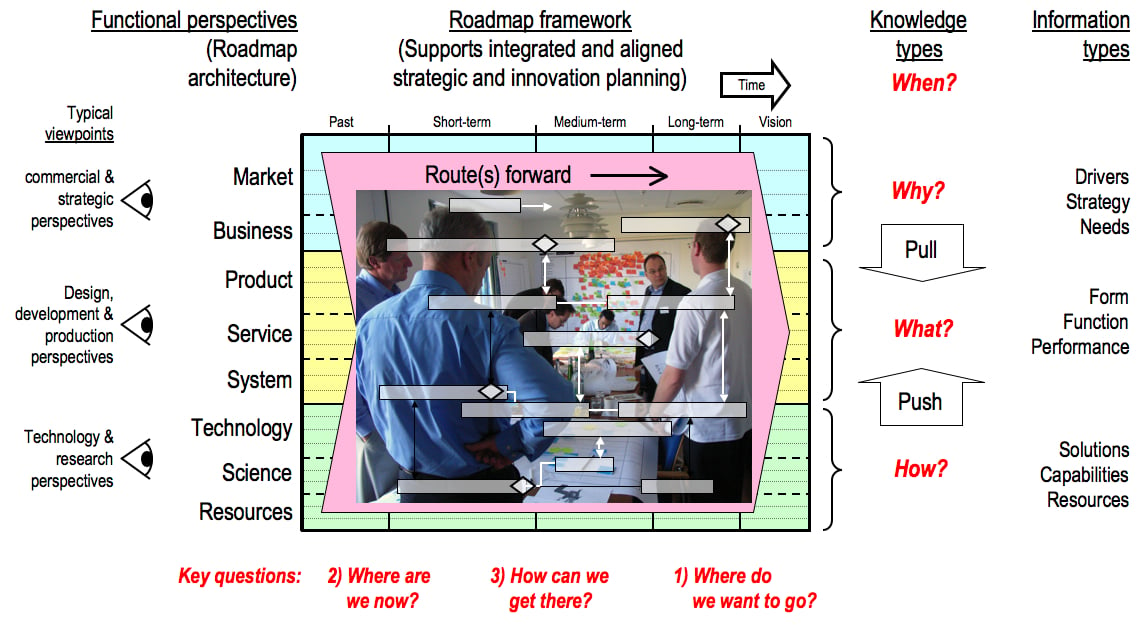The strategic roadmapping method is widely used to support innovation and strategy, ranging from product planning to business strategy and public policy development. The approach is agile and flexible, and can be readily adapted to suit the particular business context and strategic issues of interest.
At the heart of the roadmapping process is the use of structured visual representations of strategy, supporting communication and alignment within the business, and externally with suppliers, customers, investors and partners. Roadmaps are most commonly structured along two dimensions, associated with these fundamental strategic questions:
- The horizontal axis is used to represent time, including short-, medium- and long-term perspectives, addressing the first set of three key questions: Where do we want to go? Where are we now? How can we get there?
- The vertical axis depicts a series of layers representing key commercial and technical perspectives, addressing the second set of three questions: Why do we need to act? What should we do? How should we do it?
 These questions provide a generalized framework that enables the roadmapping approach to be customized and configured for the particular context and application:
These questions provide a generalized framework that enables the roadmapping approach to be customized and configured for the particular context and application:
![]() The time horizons depicted on the roadmap can be adjusted to the rate of change in the business, typically stretching 2-3 product generations forward for innovation, ranging from a couple of years for software to decades for infrastructure.
The time horizons depicted on the roadmap can be adjusted to the rate of change in the business, typically stretching 2-3 product generations forward for innovation, ranging from a couple of years for software to decades for infrastructure.
![]() The layers are structured according to hierarchical systems principles, allowing a combination of both breadth (for example, covering the full span of business activities) and depth, focusing on a particular aspect (for example, manufacturing systems).
The layers are structured according to hierarchical systems principles, allowing a combination of both breadth (for example, covering the full span of business activities) and depth, focusing on a particular aspect (for example, manufacturing systems).
The Roadmapping Process
While the initial focus is often on the roadmap, it is frequently said that the process of roadmapping is more important than the roadmap itself. The quality of a roadmap should not be judged primarily on the accuracy of the forecasts contained within it, but rather by considerations such as:
- Who was involved in the creation of the roadmap?
- What sources of information have been used, and how credible is it?
- How often is the roadmap updated?
- What decisions and actions have arisen from using the approach?
- How is the process organized and supported?
Taking a process orientation emphasizes the human aspects of roadmapping, which draws on the key knowledge and expertise in the organization. Workshops provide the ideal forum to bring together the key perspectives necessary for successful innovation, including commercial and technical functions. The roadmap structure provides a useful organization framework for this process, in the form of printed charts, supporting the capture, sharing and organizing of participant perspectives. The social process of roadmapping can be supported and extended by appropriate infrastructure, including ICT and software.
Co-creation of the roadmap ensures that key alignment points are understood, and builds buy-in for implementation of the strategy. The roadmap itself can then be used to communicate the strategy more widely within the organization, with the content and format customized as appropriate for the target audience. Aligning the roadmapping approach with the core innovation and strategy processes in the firm ensures business relevance.
Provided the right participants can be involved (which can be a major logistical challenge), it is possible to use workshops to conduct complex strategic appraisals rapidly. The scope of an entire business or sector can be covered in a day, focusing on the most crucial aspects, combining breadth and depth. Rapid iteration is beneficial, as a learning process, building consensus about the critical issues to deal with immediately, as the first steps towards the longer-term strategy and vision, supporting more responsive and agile strategic management.
Navigate the Future: Roadmapping that Works
Current research from the Fraunhofer Institute for Industrial Engineering IAO, one of Europe's leading institutions for applied research, shows that only 15% of companies surveyed use dedicated roadmapping software effectively to meet their Roadmapping and Strategic Planning needs.
Watch the recent webinar presented by Dr. Sven Schimpf, a recognized researcher and consultant with the Competence Center, R&D Management of Fraunhofer IAO and Sopheon's Hans-Cristian Eppich to learn more about:
- Fraunhofer's research findings into Roadmapping as a strategic planning tool
- How leading companies remove uncertainty from their planning and get more value from their existing pipeline with living roadmaps that are created and supported by cross-functional, enterprise software
WATCH NOW





